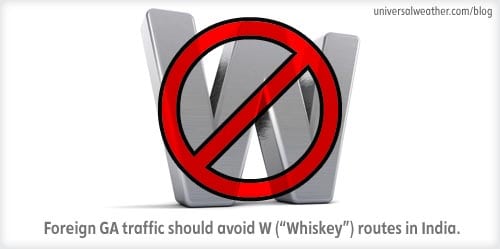5 Guidelines for Flight-Planning Your Way Through India

This business aviation blog post is part of a series on operating to India and continues from our last post titled: 10 Key Pre-Trip Airport Operations Considerations for India.
Once your permits for India are approved, you can expect a reasonable window for departure delays, but not for an earlier arrival or departure. Remember that short-notice schedule changes may not be approved. Weather can be an issue in India during monsoon season. You’ll also run into restricted visibility at times, due to fog, haze and smog at some locations. An enhanced vision system can be beneficial during operations to India.
1. Prepare for a full range of climatic conditions.
Set apart from the rest of Asia by the continental wall of the Himalayas, and stretching 2,000 miles from the border with China to its southern tip, India is home to a great variety of climatic conditions. Most of the year, the weather is hot, with variations from region to region. The coolest weather is from December to February. Conditions are really hot and dry from March to June. Monsoon rains occur in most regions between June and early October.
2. Be aware of operating restrictions that will impact your flight plan.

It’s best practice to avoid whiskey routes in your flight-planning process. W (“Whiskey”) airways in India are strictly for domestic carriers and use. However, when there’s no viable alternative between city pairs, these routings can occasionally be approved for use by non-Indian-registered aircraft. Also, keep in mind that you can operate through Indian airspace without an overflight permit, as long as you’re not crossing over the landmass.
Due to disputes between India and Pakistan, only one airway is available from eastern Pakistan into India. No airways are available over Kashmir, a disputed region between India and Pakistan, so you will not be able to overfly this airspace. Another thing to keep in mind is that operating minimums can vary between government and military-run airfields. You may be able to land at a civilian airfield with 1,000-foot visibility, but the military airport may tell you not to land unless visibility is 3,700 feet.
Pakistan-registered aircraft can operate into India only at Mumbai (VABB) and Delhi (VIDP). All aircraft flying into Kashmir must be on designated and approved air routes. However, all aircraft entering into military-controlled airfields, or overflying, are to be in positive contact with Point Alpha and Northern Control. It’s also important to note that any aircraft having air drop capability must be pre-approved through the Ministry of External Affairs.
3. Check Notices to Airmen (NOTAMs) – particularly those regarding operating curfews – pre-departure.
Notices to Airmen (NOTAMs) are created and transmitted by government agencies and airport operators under guidelines specified by Annex 15. They must always be carefully reviewed when operating to and within India. With airport infrastructure work constantly in progress across the country, you’ll run into many closed taxiways and temporarily modified ground operating procedures. Curfew hours impacting General Aviation (GA) movements are in effect at major airports, including that of Mumbai (VABB), where restrictions on operating hours shift from time to time. Currently, the Mumbai airport is closed to GA movements between 0800 to 1000 local and from 1730 to 1930 local every day. At Mumbai, there is one more time period – 2115 to 2315 local – during which only arrivals are restricted.
4. Don’t forget operating flexibility can be limited in terms of routing or destination changes.
Flight routing and destination change requests can usually be successfully accomplished when working with an experienced 3rd-party provider and if you provide at least 24 hours’ advanced notice of change. All flight requests are circulated internally to the Ministry of Intelligence, Home Ministry and various offices, depending on the sensitivity of the airports into which the operator will be flying. Based on the sensitivity of the airport or overflight area, there may be delays at times. In-flight diversions can be accommodated with clearance from air traffic control. If your route change is weather-related, it will be considered on a case-by-case basis. However, if you elect to change the route for non-operational or business reasons, you will have to get the permit revised.
5. Be aware of the potential for severe weather and limited visibility.
During monsoon season – June to early October – weather becomes an operating fact or across the subcontinent. Poor water runoff, especially in Mumbai, can create issues for ground operations. Fog has the potential of being an issue in Delhi during the winter. You’ll also encounter poor visibility due to pollution, smoke, haze and fog – and, in some cases, open fires – near many cities in India.
Questions?
If you have any questions about this article, contact Christine Vamvakas at christinevamvakas@univ-wea.com.
Later we’ll discuss navigating India’s permits, PPRs and slots.




